By Walter Sorochan
Posted date February 20, 2014, Updated Feb 27, 2014 Disclaimer The information provided below is intended for educational purposes only. It is not meant to either directly or indirectly give medical advice or prescribe treatment.

|
| Early Spanish explorers searching for fountain of youth. |
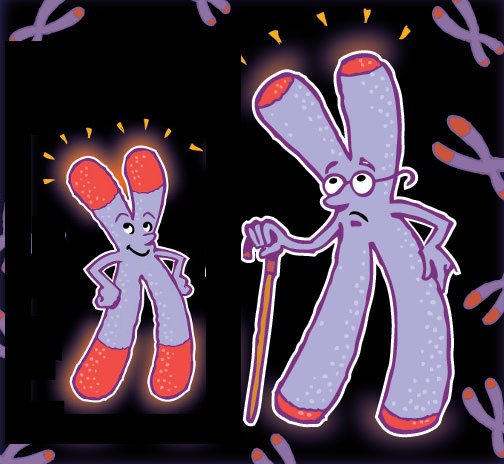 This article updates the latest information about telomeres [ red caps in image
] in a simple, easy to understand fashion and explains how telomeres
affect our life. Telomere length determines your risk and severity of all diseases by their effect on genes. So what are telomeres?
This article updates the latest information about telomeres [ red caps in image
] in a simple, easy to understand fashion and explains how telomeres
affect our life. Telomere length determines your risk and severity of all diseases by their effect on genes. So what are telomeres?
The short video below provides a superb explanation of what a telomere is; and how telomeres, chromosomes, nucleus and body cells are inter-related:
Video: Basic telomere biology Length = 1.07 mns
Source: Biology
Espanol video de telomeros [ 1:17 mns ]: Telomeros, Envejecimiento Celular - Maria Blasco
 Telomeres:
Telomeres are the protective physical caps or ends of the chromosomes and consist of repeated blocks of the DNA sequence, TTAGGG.
Telomeres:
Telomeres are the protective physical caps or ends of the chromosomes and consist of repeated blocks of the DNA sequence, TTAGGG.
The telomere protective cap [ shown in red in the right illustration ] is at the end of each of the 24 chromosomes [ light blue in the illustration ].
Telomere function:
Telomeres protect the chromosome from fusing with another and also preventing
mutations in DNA. Dr. Bill Andrews
69 has evolved an animation to help us understand how telomeres
and aging
work.  His analogy is to
"think of a DNA as a long row of bricks, and of DNA replication
as a bricklayer walking backwards on top of a brick wall laying a new layer on
top of that row. When the end of the wall is reached, the bricklayer finds
himself standing on top of the brick he's supposed to replicate. Since he can't
put down a brick where his feet are, he steps back and falls off the wall ----
leaving the very end of the wall bare. As a result, the new copy of the wall is
shorter."
His analogy is to
"think of a DNA as a long row of bricks, and of DNA replication
as a bricklayer walking backwards on top of a brick wall laying a new layer on
top of that row. When the end of the wall is reached, the bricklayer finds
himself standing on top of the brick he's supposed to replicate. Since he can't
put down a brick where his feet are, he steps back and falls off the wall ----
leaving the very end of the wall bare. As a result, the new copy of the wall is
shorter."
Just like this brick wall was copied imperfectly, our DNA in a telomere is unable to perfectly copy itself; when a strand is replicated, the new strand is shorter than the old strand.
If we lost portions of the information encoded in our DNA every time it replicated, human life would be impossible. Our cells couldn't even divide enough times to allow us to be born. Fortunately, we are born with long, repetitive sequences of DNA at the end of each of our chromosomes, which later shorten during the normal DNA replication process." 69 These repetitive sequences are called "telomeres."
Telomeres function by preventing chromosomes from losing base pair sequences [ TTAGGG ] at their ends. Telomeres protect the chromosome from fusing with another and also preventing mutations in DNA.
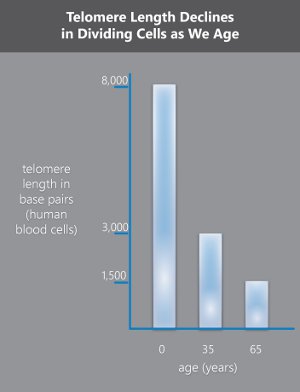 Telomeres become shorter
each time cells divide.
When we are first conceived, the telomeres in our reproductive single-cell
embryos are approximately 15,000 nucleotides long. Our cells divide rapidly in
the womb, and by the time we are born, our telomeres have decreased in length to
approximately 10,000 nucleotides. Each time a cell divides, some of the telomere
is lost ( [ usually 25-200 base pairs per division ]. They shorten throughout
our lifetime. When the telomere becomes too short, the chromosome
reaches a "critical length" and can no longer replicate. This means that a cell
becomes "old" and dies.
3
Telomeres become shorter
each time cells divide.
When we are first conceived, the telomeres in our reproductive single-cell
embryos are approximately 15,000 nucleotides long. Our cells divide rapidly in
the womb, and by the time we are born, our telomeres have decreased in length to
approximately 10,000 nucleotides. Each time a cell divides, some of the telomere
is lost ( [ usually 25-200 base pairs per division ]. They shorten throughout
our lifetime. When the telomere becomes too short, the chromosome
reaches a "critical length" and can no longer replicate. This means that a cell
becomes "old" and dies.
3
This wearing out with age process was discovered by DNA researcher, Leonard Hayflick in the 1960s, as the number of times a normal cell population will divide before it stops. Hayflick discovered that non-stem [ i.e. non-telomerase active ] cells in a dish can only divide about 60 times before the telomeres become too short to survive. The limit on a cell’s maximum lifespan is known as its "Hayflick Limit.” When the telomere is depleted, the cell dies. 4
However, telomere life may be extended by an enzyme telomerase. Unfortunately, the part of the DNA that produces telomerase is asleep in our bodies, i.e. the “switch” is turned off. We now have the ability to turn the “switch” back on to produce telomerase, which can then restore and repair the lengths of the ends of your DNA. The result is a healthier DNA and potentially a reversal of the aging process.
Telomerase adds repetitive DNA TTAGGG sequences to telomeres. Instead of gradually getting older and dying, the cells continue living indefinitely. The video below summarizes how telomerase works: [ Flash Player may be required to view the animations.]
Source: Telomerase function
Telomerase prevents DNA strands from shortening, allowing perfect cells to replicate again and again. Telomerase does this by adding repetitive sequences [nucleotides] to the ends of our chromosomes, thus lengthening our telomeres.
Telomerase works by filling the "gap" left by DNA replication thereby lengthening telomeres. This is illustrated [ below left ] by the animation created by Bill Andrews.
 Bill Andrews previously evolved an analogy animation comparing a telomere to the
brick of
a bricklayer. But instead of the bricklayer
being unable to lay the last brick on the brick wall and falling off, an
angel takes the bricklayer's place and flies in
with telomerase instead of a brick.
69
The angel is the telomerase that adds an extra DNA sequence and lengthens the
telomere. 69
Bill Andrews previously evolved an analogy animation comparing a telomere to the
brick of
a bricklayer. But instead of the bricklayer
being unable to lay the last brick on the brick wall and falling off, an
angel takes the bricklayer's place and flies in
with telomerase instead of a brick.
69
The angel is the telomerase that adds an extra DNA sequence and lengthens the
telomere. 69
Most of the somatic cells have telomerase turned "off" after birth. The exception is in the fetus, where telomerase is turned on. [ the fetus enjoys abundant telomerase until birth ] Human cells have their longest telomeres at birth, then making fewer and fewer telomeres. [ the Hayflick Limit ] There are some specialized cells that continue to produce telomerase after birth. Tissues like the lining of your mouth, your digestive and immune system need to make many copies to repair the daily natural assault from the environment. There is also another kind of cell that manages to turn "on" the telomerase production, so much so that it becomes virtually immortal -- cancer.
This lengthening gives cancer cells the ability to continuously multiply [ uncontrolled growth ]. On the other hand, telomerase activators might repair or extend the telomeres of healthy cells, thus extending their Hayflick Limit. Telomerase activation might also lengthen the telomeres of immune system cells enough to prevent cancerous cells from developing from cells with very short telomeres. 4
Telomerase and longevity: In normal cells that are not germ [ reproductive ] cells, telomerase is switched off at an early stage of development. This results in normal cells having shorter telomeres, losing their ability to divide and slowing down in growth. Scientists have found that introducing a telomerase gene into normal cells by genetic manipulation can extend a cell's life span. 5
Telomere size affects how long we will live and our predisposition to diseases. The mouse study below illustrates longevity: 6 7
|
The one on top has Short Telomeres These Mice are the Same Age! |
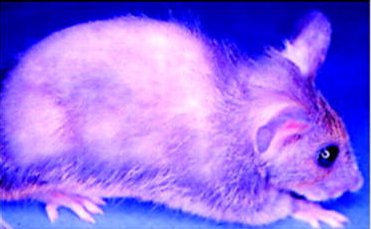
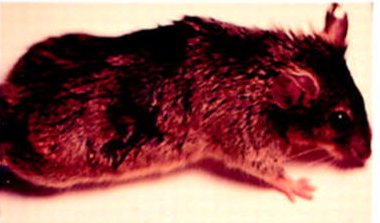
|
|
Telomeres shorten with age in somatic cells, as visualized in the picture below:

Telomere length is linked to many common disease symptoms and health conditions:
- Anxiety 8
- Brain: “brain shrinkage” was reversed and brain size reverted back to normal when this switch was turned on. 9 10
- Cancer cells have shorter telomeres than normal cells. 11 12 13 14 15 Cardiovascular diseases have shorter telomeres. 16 17 18 19 20 21 22 23 69 Telomere length was strongly associated with risk of cardiovascular death or heart attack. Death rate from heart attack was 3 times higher for men and 2.3 times higher for women whose telomeres were shorter. Patients with shorter telomeres had the highest risk. This relationship was consistent across various age groups.
- Cholesterol 24
- Chronic obstructive pulmonary disease. 25
- Eating less food preserves telomeres. 26
- Immunity: people with shorter telomeres in their immune cells had twice the risk of death from heart failure compared with people with longer telomeres. 27
- Inflammation
28
29
- Obesity 30 31 32 33
- Parkinson's Disease 34
- Sexual activity diminished. 35 36
- Smoking 37
- Stress 38 39
- Centenarians: 100 year old people, in good health had “significantly longer” telomeres than those with health problems. 40 41 42 43 44
Telomere length in animals: Animals with relatively longer telomeres for their age live longer or had higher lifetime reproductive success, suggesting that telomere length may be used as an index of individual quality. Each organism has a different DNA identification or fingerprint.

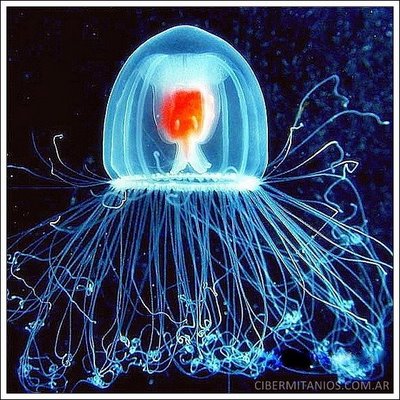 For a select few organisms, immortality is a
reality. In hydra [ tiny creatures found in most freshwater lakes, ponds, and streams ],
telomeres never get shorter. The immortal jellyfish, Turritopsis nutricula,
has the ability to, at any stage of its life, to completely reverse
its aging process.
65
Other animals living long lives include the sea anemone [indefinitely], the lobster
[140+ years],
Aldabra giant tortoises [140+], and rougheye rockfish [160 years ].
70
For a select few organisms, immortality is a
reality. In hydra [ tiny creatures found in most freshwater lakes, ponds, and streams ],
telomeres never get shorter. The immortal jellyfish, Turritopsis nutricula,
has the ability to, at any stage of its life, to completely reverse
its aging process.
65
Other animals living long lives include the sea anemone [indefinitely], the lobster
[140+ years],
Aldabra giant tortoises [140+], and rougheye rockfish [160 years ].
70
 There are also numerous plants, like the California Giant Sequoia
redwood, the aspen [birch] colony in Utah known as Pando or the Trembling Giant
tree [ on right ] estimated to be about 80,000 years old, that appear to
live forever. 71 72
These plants and animals hold the secret of long life!
There are also numerous plants, like the California Giant Sequoia
redwood, the aspen [birch] colony in Utah known as Pando or the Trembling Giant
tree [ on right ] estimated to be about 80,000 years old, that appear to
live forever. 71 72
These plants and animals hold the secret of long life!
Telomere length linked to life style: According to research led by Dr. Dean Ornish, telomere length is linked with the degree to which the men made healthy lifestyle changes; with those making more changes experiencing greater lengthening of their telomeres. 45 46
Poor lifestyle habits, as reflected in lack of physical activity, obesity, depression, accumulated stress, poor diet, inflammation and stress, speed up the shortening of telomeres. Ornish 47 and colleagues 73 determined that dietary improvements and increased exercise "significantly increase telomerase activity and consequently telomere maintenance capacity in human immune system cells."
Examples of links between telomere length and diseases:
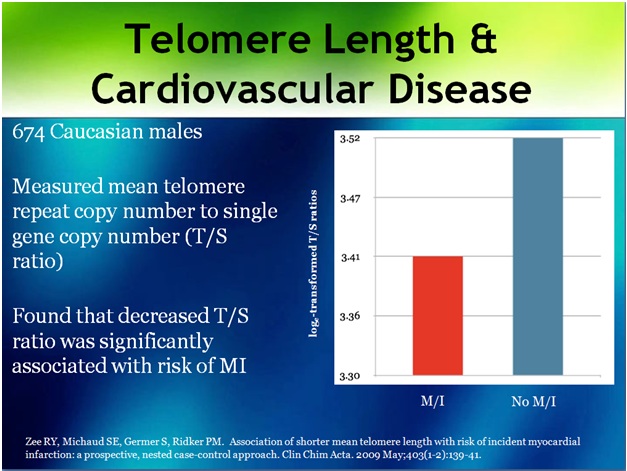 Heart
Attack: The blue bar represents the average telomere length of people who didn’t have a heart attack. The red bar shows the much shorter telomere length of the people
who did. The average telomere length of those who had a heart attack was significantly shorter than that of the people who had no heart incidents.
This information is provided by Al Sears, M.D., Power For Healthy Living.
Heart
Attack: The blue bar represents the average telomere length of people who didn’t have a heart attack. The red bar shows the much shorter telomere length of the people
who did. The average telomere length of those who had a heart attack was significantly shorter than that of the people who had no heart incidents.
This information is provided by Al Sears, M.D., Power For Healthy Living.
An example of telomere length and incidence of cancer on the left and telomere length to incidence of stroke on the right graph.
 |
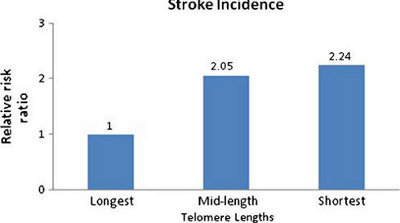 |
| Fig. 2 Relation of telomere length to incidence of cancer (Data adapted from Willeit et al.) | Fig. 3 Relation of telomere length to incidence of stroke (Data adapted from Willeit et al.) |
Telomere length [ TL ] is a measure of cumulative DNA damage from multiple environmental risk factors over an individual’s lifespan. 48 TL is likely a better predictor of Coronary Artery Disease [CAD] than the currently available risk markers, which are single, point measurements in time. Although the development and progression of atherosclerosis occurs over decades, the process is clinically silent until the manifestation of full-blown disease. The rate of telomere shortening is accelerated prior to the onset of clinical disease, so longitudinal assessments of telomere length should be a good predictor of CVD. Expect your doctor in the future to measure the length of your telomeres to help you with your health problems.
HOW TO LENGTHEN YOUR TELOMERES: A ticket to a healthier and live longer future 49 50
A. Vigorous exercise 51
B. More rest & sleep
C. Avoid sunburn
D. Avoid chorine & fluoride in drinking water
E. Avoid exposure to toxic chemicals [ air pollution, pesticides ] in environment
F. Resolve mental & psychic traumas [ stress shortens telomeres.] 52
G. Eat nutritionally balanced whole food complex diet 53 54
1. Vitamin D3
2. Highest omega-3 levels had the slowest telomere shortening. 55
3. Krill [ fish oil contains DHA that repairs over 500 genes.]
4. Ubiqinol
5. Probiotics [ fermented vegetables ]
6. Polyphenols
7. Folate 56 57
8. Vitamin B12 58
9. Curcumin [ Anti-inflammatory ]
10. Vitamin A
11. Vitamin K2
12. Magnesium 59
13. Zinc A lack of zinc in elderly people is associated with excessive numbers of short telomeres. 60
14. Vitamin C has been shown to slow the loss of telomeres in human vascular endothelial cells. 61
15. Chinese green tea 62
16. Selenium
17. Resveratrol
18. Anti-oxidants 63
[ The following has also been shown to lengthen telomere length ]:
H. TA-65: an extract from a Chinese herbal medicine that appears to turn the “switch” on to make your cells produce telomerase. TA-65 is highly purified through a proprietary extraction process from the CChinese plant Astragalus Root.
Measuring Telomere Lengths:
Two blood test techniques are available to measure telomere length:
1. Telme Health by Calvin Harley & Elizabeth Blackburn [ www.telomehealth.com ]
2. Life Length by Maria Blaco [ www.lifelength.com ]
These biomarkers are based on the belief that telomere lengths may serve as an appropriate biomarker for aging and for age-related diseases and that this knowledge may have significant implications for clinical medicine. 64 68
More helpful information about telomeres may be viewed: [ Flash Player may be required to view the animations.]
Video: Bill Andrews at Independent Research Conference 2/12/2012 Length = 1:44 hr. Andrews: Fountain of youth
Video by Elizabeth Blackburn: what are telomeres? length = 43mns. Blackburn:Telomeres
Video Bill Andrews Telomeres Reversing the aging process: length = 60 mns. Andrews: Telomeres
Summary:
This article summarized basic information about telomeres.
Chromosome DNA identify who we are, telomeres are the flames that gives us life, and telomerase ignites the spark to keep the flame alive!
Scientists, since Hayflick's demonstration, have been aware of being able to reverse aging and control diseases with telomerase for over 50 years. Unfortunately, the world appears to have suppressed such medical application.
In general, markers of poor health status are associated with relatively shorter telomeres, while markers of better health status are associated with longer telomeres
Research about telomeres has exploded since 2000. Although researchers have gained a lot of understanding about the nature of telomeres, a great deal still remains unknown. Although we do not really know the secret of some plants and animals that appear to live forever, scientists suspect that telomeres probably hold the secret of their long lives.
The future of the human race is headed in the direction of longer and healthier life spans. Telomerase gene therapy is a feasible and generally safe approach to improve health span and to treat disorders associated with short telomeres.
Telomeres = Biological Clock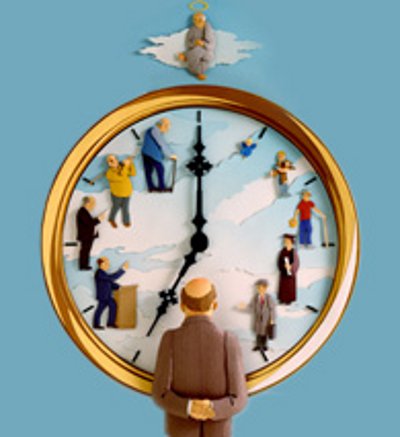 |
| source: TA-65 doctor bioclock |
Today, medical science can raise men’s life expectancy to about 86-106 years, and women’s 92-112 years based the current life expectancies at this time. Looking at other factors besides telomere shortening, oxidative stress and disease also contribute to human aging. Looking retrospectively at this century, the lifespan of both males and females has continued to increase dramatically over the years, and this would suggest that it will continue to move in an upward fashion. If the lifespan can be extended due to telomerase activity, as well as the absence of other factors it is hypothesized by Cawthon that the human lifespan could eventually reach 1,000 years. 67 Such future possibilities would create new problems like what to do with all the aging population! But this is an issue for another day.
Scientist Kaku discusses adopting telomere research to clinical medicine in the video below.
Video Michio Kaku explains how to reverse aging Length = 4:37 mns
Source: Kaku:
reverse aging
Your feedback is most appreciated: E-mail to: Author Walter Sorochan
To return to: web-site main page
References:
1 Haber Carole, "Life Extension and History: The Continual Search for the Fountain of Youth," Journal of Gerontology: BIOLOGICAL SCIENCES Copyright 2004, Vol. 59A, No. 6, 515–522. Haber: Fountain of youth 2004
2 Wikipedia, Elizabeth Blackburn." Wiki: Blackburn
3 Southwestern University, "Facts about telomeres and telomerase," 2008. SWU: Teleform info
4 Wikipedia, "Hayflick limit." Wiki: Hayflick limit
5 Serrano, Antonio L. Vicente Andrés, "Review Telomeres and Cardiovascular Disease, Does Size Matter?" Circulation Research, February 4, 2004. Serrano: review CVD & telomeres 2004
6 Jaskelhoff Mariela, and others, "Telomerase reactivation reverses tissue degeneration in aged telomerase-deficient mice," Nature, January 6, 2011;469(7328):102-6. Jaskelhoff: Telomere reverses aging 2011
7 Willeit Peter and others, "Longitudinal Changes in Leukocyte Telomere Length and Mortality in Humans," J Gerontol A Biol Sci Med Sci, 2014: 69A (2): 231-239, first published online October 22, 2013. Willeit: telomere length & mortality 2014
8 Okereke OI, Prescott J, Wong JYY, Han J, Rexrode KM, et al., "High Phobic Anxiety Is Related to Lower Leukocyte Telomere Length in Women," PLoS ONE, 2012,7(7): e40516. doi:10.1371. Okereke: Anxiety lin telomeres 2012
9 Jaskelhoff Mariela, and others, "Telomerase reactivation reverses tissue degeneration in aged telomerase-deficient mice," Nature, January 6, 2011;469(7328):102-6. Jaskelhoff: Telomere reverses aging 2011
10 Wikgren M, Karlsson T, Söderlund H, Nordin A, Roos G, Nilsson LG, Adolfsson R, Norrback KF.,"Shorter telomere length is linked to brain atrophy and white matter hyperintensities," Age Ageing. November 14, 2013. Wikgren: Brain & telomeres 2013
11 Aida J. and others, "Telomere lengths in the oral epithelia with and without carcinoma," Eur J Cancer, January 2010;46(2):430-8. Aida: mouth cancers & telomeres 2010
12 Diehl Malissa C., "Elevated TRF2 in advanced breast cancers with short telomeres," Breast Cancer Res Treat, June 2011, 127(3): 623–630. Published online July 13, 2010. Diehl: cancer elevated in short telomeres 2010
13 McGrath Monica, "Telomere Length, Cigarette Smoking, and Bladder Cancer Risk in Men and Women," Cancer Epidemiol Biomarkers Prev, April 2007. McGrath: smoking & telomeres 2007
14 Rampazzo E, and others, "Relationship between telomere shortening, genetic instability, and site of tumour origin in colorectal cancers," British Journal of Cancer, April 13, 2010. Rampazzo: colon cancer & telomeres 2010
15 Shen J, Gammon MD, Terry MB, Wang Q, Bradshaw P, Teitelbaum SL, Neugut AI, Santella RM., "Telomere length, oxidative damage, antioxidants and breast cancer risk," Int J Cancer, April 2009, 1;124(7):1637-43. Shen: Antioxidants lengthen telomeres prevent cancer 2009
16 Carlquist John and others, "Telomere Length Predicts the Life Expectancy of Patients with Heart Disease," Intermountain Medical Center, SciTechDaily, March 11, 2013. Carlquist: telomere length heart disease 2013
17 Day Michael, "Shrinking telomeres linked to heart disease," New Scientist, January 12, 2007. Day: Telomeres linked to heart disease 2007
18 Farzaneh-Far R, et. al. “Association of Marine Omega-3 Fatty Acid Levels With Telomeric Aging in Patients With Coronary Heart Disease.” JAMA, 2010; 303(3): 250. Farzaneh-Far: Fatty-acids & telomeres 2010
19 Farzaneh-Far Ramin, Jue Lin, Elissa Epel, Kyle Lapham, Elizabeth Blackburn, Mary A. Whooley," Telomere Length Trajectory and Its Determinants in Persons with Coronary Artery Disease: Longitudinal Findings from the Heart and Soul Study," PLoS ONE, January 08, 2010, 5(1): e8612. doi:10.1371. Farzaneh-Far: Telomere heart study 2010 "Heart disease, age, male sex, and abdominal obesity also independently predicted telomere shortening."
20 Serrano, Antonio L. Vicente Andrés, "Review Telomeres and Cardiovascular Disease, Does Size Matter?" Circulation Research, February 4, 2004. Serrano: review CVD & telomeres 2004
21 Terai M, Izumiyama-Shimomura N, et. al. "Association of Telomere Shortening in Myocardium With Heart Weight Gain and Cause of Death." Sci Rep. 2013;3:2401. Terai: telomere & death 2013
22 Willet P. and others, "Cellular aging reflected by leukocyte telomere length predicts advanced atherosclerosis and cardiovascular disease risk," Arterioscler Thromb Basc biol, 2010;30:1649-56. Willet: cell age & telomere length 2010
23 Zee R, Michaud S, Germer S, Ridker P. “”Association of shorter mean telomere length with risk of incident myocardial infarction: a prospective, nested case-control approach.”” Clin Chim Acta. 2009 May;403(1-2):139-41. Zee: Telomeres & heart attack 2009
24 Tulane Center for Cardiovascular Health, "Leukocyte telomere length is associated with HDL cholesterol levels: The Bogalusa heart study," Atherosclerosis, August 2009, 205(2):620-5. Tulane: Cholesterol linked to tolomere 2009
25 Houben JM, Mercken EM, Ketelslegers HB, Bast A, Wouters EF, Hageman GJ, Schols AM., "Telomere shortening in chronic obstructive pulmonary disease," Respir Med, February 2009, 103(2):230-6 Houben: POD linked to telomeres 2009
26 Chunfang Wang, et al., "Insight Into Why Low Calorie Diet Can Extend Lifespan -- Even If Adopted Later in Life," British Society for Research on Ageing, July 2010. Chunfang Low Cal extend telomeres 2010
27 Farzaneh-Far R, et. al. “Association of Marine Omega-3 Fatty Acid Levels With Telomeric Aging in Patients With Coronary Heart Disease.” JAMA, 2010; 303(3): 250. Farzaneh-Far: Fatty-acids & telomeres 2010
28 Cipriano C, et la., "Accumulation of cells with short telomeres is associated with impaired zinc homeostasis and inflammation in old hypertensive participantsm" J Gerontol A Biol Sci Med Sci. July 2009, 64(7):745-51. Cipriano: Zinc lengthens telomeres 2009
29 Masi S, Salpea KD, Li K, Parkar M, Nibali L, Donos N, Patel K, Taddei S, Deanfield JE, D'Aiuto F, Humphries SE., "Oxidative stress, chronic inflammation, and telomere length in patients with periodontitis. Free Radic Biol Med, March 2011, 15;50(6):730-5. Masi: inflammation, and telomere length 2011
30 Farzaneh-Far Ramin, Jue Lin, Elissa Epel, Kyle Lapham, Elizabeth Blackburn, Mary A. Whooley," Telomere Length Trajectory and Its Determinants in Persons with Coronary Artery Disease: Longitudinal Findings from the Heart and Soul Study," PLoS ONE, January 08, 2010, 5(1): e8612. doi:10.1371. Farzaneh-Far: Telomere heart study 2010
31 García-Calzón S and others, "Longitudinal association of telomere length and obesity indices in an intervention study with a Mediterranean diet: the PREDIMED-NAVARRA trial," International Journal of Obesity, 2014, 38, 177–182; doi:10.1038/ijo.2013.68; published online 28 May 2013. García-Calzón: obesity & telomeres 2014
32 Kim S, Parks CG, DeRoo LA, Chen H, Taylor JA, Cawthon RM, Sandler DP., "Obesity and weight gain in adulthood and telomere length," Cancer Epidemiol Biomarkers Prev. 2009 Mar;18(3):816-20. doi: 10.1158/1055-9965.EPI-08-0935. Kim: Obesity & telomeres 2009
33 Martínez Paula, Gonzalo Gómez-López, Fernando García, Evi Mercken, Sarah Mitchell, Juana M. Flores, Rafael de Cabo, Maria A. Blasco, "RAP1 Protects from Obesity through Its Extratelomeric Role Regulating Gene Expression," Cell Reports, 2013; DOI: 10.1016/j.celrep.2013.05.030 Martínez: 2013 Obesity & telomeres
34 Watfa G, Dragonas C, Brosche T, Dittrich R, Sieber CC, Alecu C, Benetos A, Nzietchueng R., "Study of telomere length and different markers of oxidative stress in patients with Parkinson's disease," J Nutr Health Aging, April 15, 2011. Watfa: Parkinson's disease & telomeres 2011
35 Farzaneh-Far Ramin, Jue Lin, Elissa Epel, Kyle Lapham, Elizabeth Blackburn, Mary A. Whooley," Telomere Length Trajectory and Its Determinants in Persons with Coronary Artery Disease: Longitudinal Findings from the Heart and Soul Study," PLoS ONE, January 08, 2010, 5(1): e8612. doi:10.1371. Farzaneh-Far: Telomere heart study 2010 "Heart disease, age, male sex, and abdominal obesity also independently predicted telomere shortening."
36 Jaskelhoff Mariela, and others, "Telomerase reactivation reverses tissue degeneration in aged telomerase-deficient mice," Nature, January 6, 2011;469(7328):102-6. Jaskelhoff: Telomere reverses aging 2011
37 McGrath Monica, "Telomere Length, Cigarette Smoking, and Bladder Cancer Risk in Men and Women," Cancer Epidemiol Biomarkers Prev, April 2007. McGrath: smoking & telomeres 2007
38 Epel, E.S., E.H. Blackburn, J. Lin, F. Dhabar, N. Adler, J. Morrow, and R. Cawthon, "Accelerated telomere shortening in response to life stress, Proc Natl Acad Sci USA, 2004, 101: 17312-15. Epel: Stress & telomeres 2004
39 Malan S, Hemmings S, Kidd M, Martin L, Seedat S., "Investigation of telomere length and psychological stress in rape victims, Depress Anxiety, December 2011, 21;28(12):1081-5. [ Post traumatic stress ] Malan: Pysch stress & telomeres 2011
40 Dellara F. Terry, Vikki G. Nolan, Stacy L. Andersen, Thomas T. Perls and Richard Cawthon, "Association of Longer Telomeres With Better Health in Centenarians," The Journals of Gerontology: Series A May 13, 2008, Volume 63, Issue 8,Pp. 809-812. Dellara: longevity & telomeres 2008
41 Jaskelhoff Mariela, and others, "Telomerase reactivation reverses tissue degeneration in aged telomerase-deficient mice," Nature, January 6, 2011;469(7328):102-6. Jaskelhoff: Telomere reverses aging 2011
42 Muzumdar Radhika and Gil Atzmon, "Telomere Length and Aging," Reviews on Selected Topics of Telomere Biology. Muzumdar: Telomere Length and Aging
43 Telomere Biosciences, "Telomere Biosciences Announces: TELO-100 with T-Activator 150, a Breakthrough in Telomere Science and Age Management," PRNewswire, November 21, 2013. Telomere Biosciences: Nutraceutical telomerase 2013
44 Willeit Peter and others, "Longitudinal Changes in Leukocyte Telomere Length and Mortality in Humans," J Gerontol A Biol Sci Med Sci, 2014: 69A (2): 231-239, first published online October 22, 2013. Willeit: telomere length & mortality 2014
45 Ornish Dean, "Effect of comprehensive lifestyle changes on telomerase activity and telomere length in men with biopsy-proven low-risk prostate cancer: 5-year follow-up of a descriptive pilot study," The Lancet Oncology, October 2013, Volume 14, Issue 11, Pages 1112 - 1120. Ornish: Telomeres & life style 2013
46 Muzumdar Radhika and Gil Atzmon, "Telomere Length and Aging," Reviews on Selected Topics of Telomere Biology. Muzumdar: Telomere Length and Aging
47 Ornish Dean, "Effect of comprehensive lifestyle changes on telomerase activity and telomere length in men with biopsy-proven low-risk prostate cancer: 5-year follow-up of a descriptive pilot study," The Lancet Oncology, October 2013, Volume 14, Issue 11, Pages 1112 - 1120. Ornish: Telomeres & life style 2013
48 Telomere Biosciences, "Telomere Biosciences Announces: TELO-100 with T-Activator 150, a Breakthrough in Telomere Science and Age Management," PRNewswire, November 21, 2013. Telomere Biosciences: Nutraceutical telomerase 2013
49 Mercola, "Story at a glance," Mercola.com, May 09, 2012. Mercola: Nutrition for long telomeres
50 Wilson Lawrence, " Telomeres and how to lengthen them," The Center For Development, April 2013. Wilson: Telomere lengthening 2013
51 Ornish Dean, "Effect of comprehensive lifestyle changes on telomerase activity and telomere length in men with biopsy-proven low-risk prostate cancer: 5-year follow-up of a descriptive pilot study," The Lancet Oncology, October 2013, Volume 14, Issue 11, Pages 1112 - 1120. Ornish: Telomeres & life style 2013
52 Epel, E.S., E.H. Blackburn, J. Lin, F. Dhabar, N. Adler, J. Morrow, and R. Cawthon, "Accelerated telomere shortening in response to life stress, Proc Natl Acad Sci USA, 2004, 101: 17312-15. Epel: Stress & telomeres 200453 Mercola, "Story at a glance," Mercola.com, May 09, 2012. Mercola: Nutrition for long telomeres
54 Richards Byron J., "Nutrition makes anti-aging possible: secrets of your telomeres," NewsWithViews.com, December 10, 2013 Richards: telomere secrets 2013
55 Farzaneh-Far R, et. al. “Association of Marine Omega-3 Fatty Acid Levels With Telomeric Aging in Patients With Coronary Heart Disease.” JAMA, 2010; 303(3): 250. Farzaneh-Far: Fatty-acids & telomeres 2010
56 Fenech M., "Folate (vitamin B9) and vitamin B12 and their function in the maintenance of nuclear and mitochondrial genome integrity," Mutat Res., November 2011. Fenech: Folate, vitamin B12 lenghten telomeres 2011
57 Paul L, Cattaneo M, D'Angelo A, Sampietro F, Fermo I, Razzari C, Fontana G, Eugene N, Jacques PF, Selhub J., "Telomere length in peripheral blood mononuclear cells is associated with folate status in men," J Nutr. July 2009, 139(7):1273-8. Paul: folic acid link telomeres 2009
58 Fenech M., "Folate (vitamin B9) and vitamin B12 and their function in the maintenance of nuclear and mitochondrial genome integrity," Mutat Res., November 2011. Fenech: Folate, vitamin B12 lenghten telomeres 2011
59 Martin H, Uring-Lambert B, Adrian M, Lahlou A, Bonet A, Demougeot C, Devaux S, Laurant P, Richert L, Berthelot A., "Effects of long-term dietary intake of magnesium on oxidative stress, apoptosis and ageing in rat liver," Magnes Res, June 2008, 21(2):124-30. Martin: Mg deficience shorter telomeres 2008
60 Cipriano C, et la., "Accumulation of cells with short telomeres is associated with impaired zinc homeostasis and inflammation in old hypertensive participantsm" J Gerontol A Biol Sci Med Sci. July 2009, 64(7):745-51. Cipriano: Zinc lengthens telomeres 2009
61 Furumoto K, Inoue E, Nagao N, Hiyama E, Miwa N. Age-dependent telomere shortening is slowed down by enrichment of intracellular vitamin C via suppression of oxidative stress. Life Sci. Decembe 1998 63(11):935-48. Furumoto: Vit C protects telomeres 1998
62 Chan Ruth, Jean Woo, Eddie Suen, Jason Leung and Nelson Tang, "Chinese tea consumption is associated with longer telomere length in elderly Chinese men," British Journal of Nutrition. January 2010, Volume 103/Issue 01, pp 107-113. Chan: tea lengthens telomeres 2010
63 Shen J, Gammon MD, Terry MB, Wang Q, Bradshaw P, Teitelbaum SL, Neugut AI, Santella RM., "Telomere length, oxidative damage, antioxidants and breast cancer risk," Int J Cancer, April 2009, 1;124(7):1637-43. Shen: Antioxidants lengthen telomeres prevent cancer 2009
64 Fossel Michael, "Use of telomere length as a biomarker for aging and age-related disease," Current Translational Geriatrics and Experimental Gerontology Reports, June 10, 2013, Vol 1, Issue 2, pp. 121-127. Fossel: Telomere biomarkers 2012
65 Ericfein, "mortal Animals and the Human Link," WonderRecessive Health Science Technology, July 7, 2013. Ericfein immortal jellyfish, lobsters 2013
66 TA-65 doctor, "Telomerase Activation." TA-65 doctor bioclock
67 Siegal Lee J., "Are Telomeres the key to aging and cancer?" Genetic Science learning center, The University of Utah, January 2, 2006. Siegel: learning center 2006
Hydra has ability to live forever! Although it is unknown precisely how hydra maintain their telomere length so impeccably, recent studies have revealed that a gene called FoxO, which has a direct influence on stem cells, is likely the answer. When FoxO activity is reduced in Hydra their powers wane and they suddenly show signs of aging. FoxO is also responsible for stem cell activity in humans. Greater FoxO activity is routinely found in people with abnormally long lifespans, like centenarians. It may be possible to increase FoxO activity from an early age, maintain levels of stem cells in the body, and thus increase human lifespan by 1000′s of years; maybe even forever."
68 Cwynar Eva, Telomere testing, Cwynar: Telomere testing
69 Andrews Bill, and Jon Cornell, "Bill Andrews on Telomere Basics: CURING AGING," Sierra Sciences, 2010. Andrews: curing aging 2010
69 Cawthon, R. M., K. R. Smith, et al. . "Association between telomere length in blood and mortality in people aged 60 years or older." Lancet, 2003, 361(9355): 393-5. Cawthon: death 7 telomeres 2003
70 Russo Juniper, "5 immortal animals," Voices Yahoo, January 6, 2011. Russo: Immortal animals 2011
71 Palmer Roxanne, "Immortal Jellyfish To Ageless Aspen Trees: Animals And Plants Who Found The Fountain Of Youth," International Business Times, January 07, 2013. Palmer: ageless trees 2013
72 Leaf & Limb Tree Service, "The World’s Oldest Trees," 2014. World's oldest trees
73 Wyatt Holly, "Longer Telomeres Through Healthy Living," Aegis, November 7, 2013. Wyatt: exercise & telomeres 2013
Aging reversed in mice: Researchers gave lab mice a special compound [telomerase] that acted on a part of the DNA that activates a hidden part of the DNA to produce an enzyme called telomerase. The result was a reversal of all these signs of aging. The mice’s intelligence not only came back, but it reverted back to youthful status. The shrinkage of the brain reversed, their hair became shiny and thick again, and there eyesight returned. In addition, they became sexually active again and fertility returned. Jaskelhoff: Telomere reverses aging 2011
Base pairs: In human blood cells, the length of telomeres ranges from 8,000 base pairs at birth to 3,000 base pairs as people age and as low as 1,500 in elderly people. [ An entire chromosome has about 150 million base pairs.) ] Each time a cell divides, an average person loses 30 to 200 base pairs from the ends of that cell's telomeres. Cells normally can divide only about 50 to 70 times, with telomeres getting progressively shorter until the cells become senescent, die or sustain genetic damage that can cause cancer. Telomeres do not shorten with age in tissues such as heart muscle in which cells do not continually divide.
Bodnar, et al., "Extension of life-span by introduction of telomerase into normal human cells," Science, 1998.
Calado Rodrigo and Neal Young "Telomeres in disease," The Scientist, May 1, 2012. Calado: Telomeres & disease 2012
"Telomere Timeline: In the 1930s, Hermann Muller and Barbara McClintock observed that fragmented chromosomes tended to fuse with each other, while normal chromosomes were stable, and they predicated characteristics of the “natural ends” to explain this difference. Muller named these ends “telomeres.” Almost 40 years later, Alexey Olovnikov, on theoretical grounds, and James Watson, based on phage experiments, recognized a fundamental problem regarding the mechanics of DNA replication, during which a small amount of genetic information is lost with every cell division. In the late 1970s, Elizabeth Blackburn and Joseph Gall discovered the structure of telomeres—short, highly repetitive noncoding nucleotide sequences—in the ciliated protozoan Tetrahymena. In 1982, Blackburn and Jack Szostak elucidated how telomeres in yeast could serve as a buffer for the coding DNA during replication, and postulated the existence of an enzyme that could rebuild telomeres—an enzyme discovered by Blackburn and Carol Greider in Tetrahymena 3 years later. By 1988, the sequence of the human telomere was known, and researchers began actively investigating its role in aging and cancer. Subsequent work showed that the telomeres in certain proliferative cells are actively repaired. For their work on telomeres, Blackburn, Greider, and Szostak were awarded the 2009 Nobel Prize in Physiology or Medicine. "
Cassidy, Aedin et al., "Associations between diet, lifestyle factors, and telomere length in women," The American Journal of Clinical Nutrition, 2010, (1273-1280) Cassidy: lifestyle & telomeres 2010
Hayflick Limit: It was once believed that cell lines were immortal. But to reproduce, each successive generation of cells needs to unzip and copy all 46 chromosomes, giving each daughter a perfect copy. Leonard Hayflick discovered that non-stem (i.e. non-telomerase active) cells in a dish can only divide around 60 times before the telomeres become too short to survive. The limit on a cell’s maximum lifespan with respect to its descendants is known as its “Hayflick Limit.” Because DNA is unzipped and copied from an original, complimentary strand, any daughter cell’s telomeres can’t be longer than its mother’s and will actually be shortened each division. This is known as …. Replicative Senescence.
Highfield Roger, "How Henrietta's cells gave us new hope," The Telegraph, August 18, 2007. Highfield: cells living forever in lab 2007 "The study of cancer cells that never die has helped researchers better understand aging. Henrietta Lack's cancer cells HeLa have become standard medical lab tool for testing medications and so on."
Horner J, Maratos-Flier E, Depinho R, et. al. “Telomerase reactivation reverses tissue degeneration in aged telomerase-deficient mice.” Nature, January 6 2011;469(7328):102-6. Jaskelhoff: Telomere reverses aging 2011
How telomeres work: Telomere DNA has over 1000 bases [ building blocks ], with the sequence TTAGGG, that repeats over and over. In order to divide, a normal cell has to replicate all the DNA in its chromosomes. But normal cells have difficulty in copying the last few bases on the telomere. As a result, the telomere shortens with each round of DNA replication and cell division. As a cell ages, the telomere keeps shortening until it reaches a finite length. At that point cells stop dividing. This halt in growth is triggered by a gene called p53 that is activated in response to DNA damage. A telomere that has become too short no longer protects the chromosome from DNA damage. When the damage takes place, p53 responds by stopping cell replication and forces it into senescence.
Lamb Neil," Telomeres - the aglets of the genomic world," Hudson_Alpha Institute for biotechnology, 2009-10 Winter Lamb: Telomeres 2010
Makpol S, Durani LW, Chua KH, Mohd Yusof YA, Wan Ngah WZ., "Tocotrienol-rich fraction prevents cell cycle arrest and elongates telomere length in senescent human diploid fibroblasts," J Biomed Biotechnol, March 2011. Makpol: Vit E ectends telomeres 2011
Noble prize in Physiology/Medicine in 2008 [ for the discovery of how chromosomes are protected by telomeres ]:
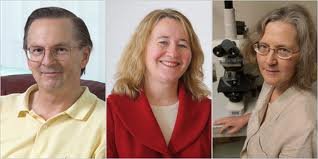
Jack W. Zostak, Carol W. Greider, Elizabeth H. Blackburn
O'Connor, C., "Telomeres of human chromosomes," Nature Education, 2001, 1(1):166. O'Connor: Telomere replication 2001
Papp Z, Czuriga D, Balogh L, Balogh Á, Borbély A., "How Cardiomyocytes Make The Heart Old." Curr Pharm Biotechnol," 2012;13(13):2515-21.
Richards J Brent, "Higher serum vitamin D concentrations are associated with longer leukocyte telomere length in women," American Society for Clinical Nutrition, 2007. Richards: Vit D lengthens telomeres 2007
Tomas, et al., "Telomerase Reverse Transcriptase Delays Aging in Cancer-Resistant Mice," Cell, November 14, 2008, 135, 609–622. Tomas: telomerase delays aging 2008
Willeit Peter, Willeit Johann, Mayr Anita, Weger Siegfried, Oberhollenzer Friedrich, Brandstätter Anita, Kronenberg Florian, Kiechl Stefan, "Telomere length and risk of incident cancer and cancer mortality," JAMA 2010, 304 (1): 69–75. Willeit cancer & telomere lemgth2010
Wonga Liza S.M., Rudolf A. de Boera, Nilesh J. Samanib, Dirk J. van Veldhuisena and Pim van der Harsta, "Telomere biology in heart failure," European Journal of heart failure, 2008, 10 (11): 1049-1056. Wonga: Telomeres & heart failure 2008 "There was a statistically significant inverse relationship between telomere length and both cancer incidence and mortality."